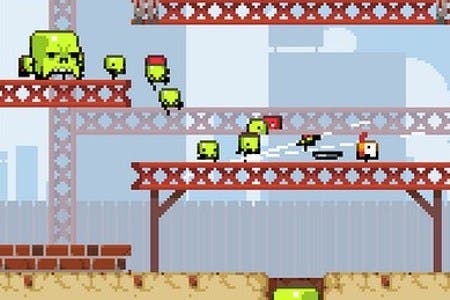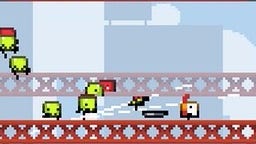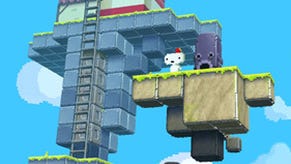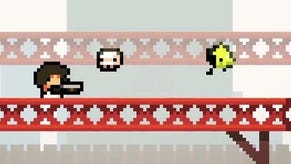Super Crate Box Review
Crate out of ten?
It's hard to believe that Super Crate Box came out on Macs and PCs as recently as 2010. It feels like I've been playing it forever. That's not because I'm any good at it, mind. It's more likely because I'm intimately aware of all the ways I'm not any good at it. I know I lurk too much on the safer mid-level platforms of the Moon Temple stage and then get overwhelmed, for example. I know I'm scared of weapons like the disc gun and the laser rifle, so I've never really mastered their quirks. I know I flip out completely whenever the little floating skull guys turn up and that I often fall in the flaming pit at the bottom of the screen entirely by accident.
There's another reason it's hard to believe Vlambeer's fast-paced blaster is only two years old, though, and that's because Super Crate Box, while oozing with indie credibility, feels like a classic arcade game from the Eugene Jarvis era. It's got a great line in tight, replayable maps, it's got dribbling horrors to populate them with, and it's got some adorable, savagely differentiated weaponry to keep you alive.
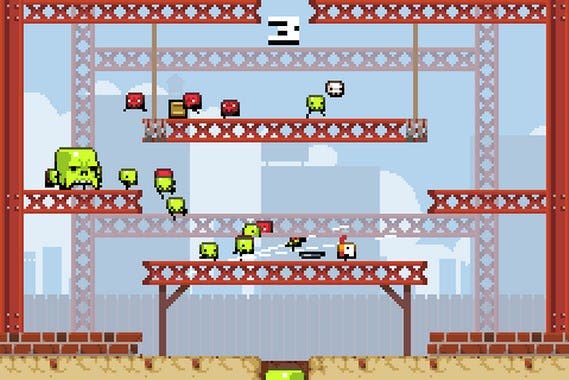
Like Robotron or Defender, Super Crate Box is a brisk tutorial in how less really can be more when it comes to design. You could list its handful of ideas on the back of a rail ticket, and yet they provide enough structure to build a game that you can then pretty much play until the end of time.
That's because they're good ideas. It turns out that they're good enough to survive the transition from PC keyboard to iOS touch-screen with little or no obvious compromise.
Super Crate Box is a simple high-score chaser in essence, albeit a high-score chaser in which you're going to really struggle to score highly. There are three maps to choose from, and they're all side-on, single-screen affairs with platforms to jump between and holes at the top and the bottom for enemies to trickle through. Speaking of enemies, the ones that initially drop into the playing field are mean enough, but by the time they've made their way to the lowest platform of a level, fallen into that fire pit, and re-emerged at the top again, they're even nastier: faster, redder, and - well, they're faster and redder, anyway.
Whatever colour they are, they remain largely brainless, the big and little stalkers just waddling along without a care in the world - or a lower jaw, come to think of it - while only the hovering white skulls possess any loose player-seeking abilities. Killing them all is pretty easy, and the arsenal at your disposal is fantastically over-powered. The only problem is that dispatching baddies doesn't score you points. Collecting crates scores you points, and these spawn randomly on the map, and switch out your current weapon whenever you grab one.
Sometimes you end up with a new gun that's perfect for your current situation, and the giddy carnival of murder continues. Sometimes you get a gun that is tantamount to a death warrant and it's back to the start again. Scoring a crate always means taking a risk, then, and Vlambeer's greatest skill as a developer lurks with its ability to manipulate its audience, forcing you to constantly race around the map and leave the safety of your favourite gadgets and cherished hiding places behind. Guns, crates, scoring and enemies are all knotted together with ingenious cruelty here, and the player is tangled up right in the middle.
Hence the famous Super Crate Box churn: a ceaseless grind of pixelated death in which you're always moving, always shooting, and always cycling through your arsenal. It wouldn't work if that arsenal wasn't so dazzling, but from the lazy, bouncing arc of the grenade launcher through to the localised fragmentary punch of the shotgun, the artillery is loud and excessive and fraught with terrible, hilarious weaknesses. The laser rifle can burn through an entire row of baddies at once, but it takes forever to charge. The mini-gun pours out lead without taking a break, but it shunts you backwards as it does so. The disc gun's projectiles rebound whenever they hit a piece of the scenery, the katana has a feeble attack radius, and the flamethrower leaves you hopping up and down with your feet on fire. Don't even get me started on the dual pistols or the mines - or the bazooka, which comes with those toxic strings of black cloud that follow in its wake.
On iOS, a game that hinges on the kind of split-second control that Super Crate Box demands could be a disaster, but that isn't the case here. With The Blocks Cometh developer Halfbot on board for the port (trivia: like Vlambeer, they're another great team whose work has been cloned by scumbags), the virtual buttons are pleasant, well-positioned and offer an instantaneous sense of connection for both jumping and shooting. The unlockable special modes are still available if you've got the skills to reach them, the frame-rate never stutters, the game works well in portrait or landscape, and there are no real concessions or bugs, except for the fact that the slight parallax scrolling effect on the background has been taken out, and you can very occasionally catch yourself on the edge of a platform and hang for a millisecond or two.
The crucial feel of the game has survived, in other words, as have a handful of tiny yet similarly crucial details, like the way the shotgun ejects dinky little shells after each blast, or the manner in which your flickering cameo appears on the security screens of the Missile Silo level. Comparing the statistics from my hundreds of hours of playing on Mac and the dozens of hours I've already notched up on the iPad reveals that I tend to score roughly the same on both platforms. That's got to be a good sign - and I think I may even prefer the touch-screen version. There's something indefinably great about being able to lie back on the sofa with tea nearby and retro-tinged murder at your fingertips. You should try it.
Super Crate Box may not be new, then, but on iOS it's not to be missed. This belongs up there with Drop7, Solipskier and SpellTower as an example of the very best that the App Store offers. It's endlessly cheerful, and cheerfully deadly, and it's the perfect digital companion for the month of January, with its frosty clarity and new years' resolutions. Here is a piece of design that offers a path to true mastery through careful practice. Here is a game that provides unceasing opportunities for self-improvement.
